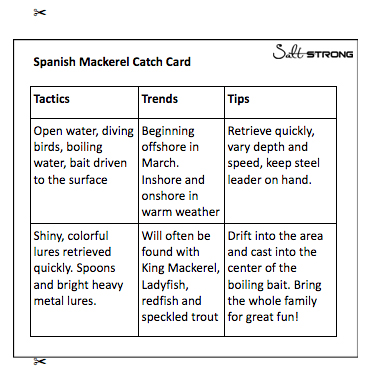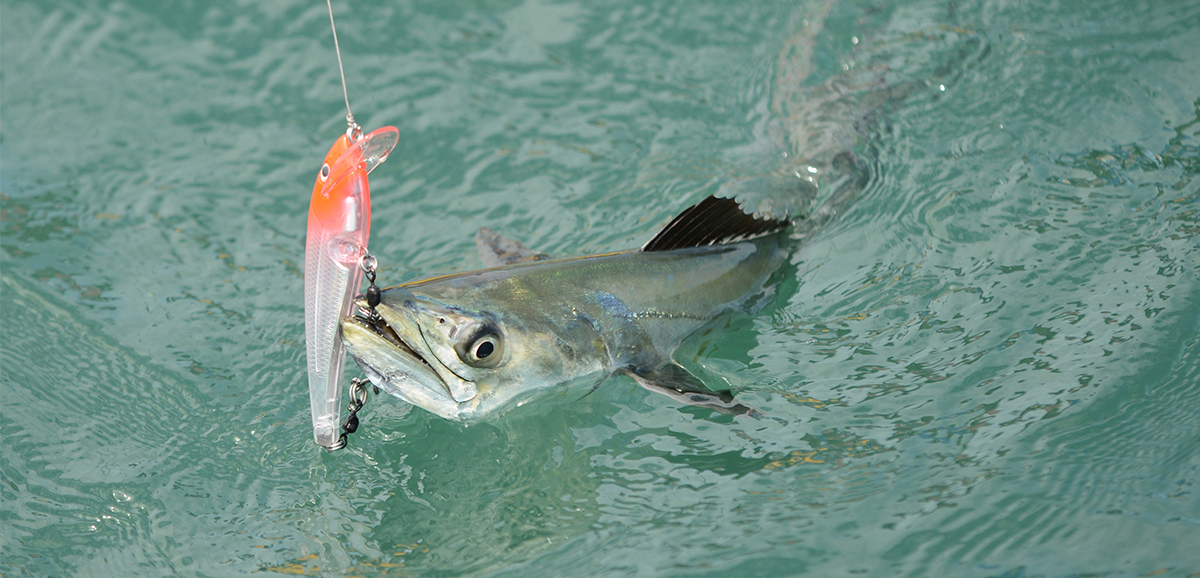It’s Spanish Mackerel time!
Insider member, Daniel Flinn, is back with another excellent how-to article and PDF catch card.
You might recognize Daniel Flinn from some of his other articles here:
- How To Catch Sheepshead (Plus PDF Cheat Sheet & Catch Card)
- How To Catch Black Drum (Plus PDF Cheat Sheet & Catch Card)
- How To Catch Flounder (Plus PDF Cheat Sheet & Catch Card)
This time he’s teaching us all about how to catch Spanish mackerel.
You’ll learn:
- When and where to find them (plus telltale signs that they’re in the area)
- How to retrieve your lure for maximum strikes
- The gear (and specific type of leader) to use so you can bring more macks to the boat
- Why they make great targets for a family fishing trip
Enjoy and don’t forget to download your free PDF catch card here!
Spanish Mackerel
Scomberomorous Maculatus

Where:
- Offshore in open waters around structure
- Nearshore around open water, including flats and oyster bars
- Onshore in the surf and near piers, especially during the warmer weather
When:
- From March to September
- As the water warms, they will come closer to shore
Gear:
- Light to medium spinning or bait casting tackle preferred
- Medium to stout 7 to 8-foot rod
- 12-20 lb. braided line
- 30-40 lb. fluorocarbon leader; steel leader if losing gear
- 1/0-2/0 circle hook to match bait size
- Bobber, especially one that attracts upon intermittent retrieval.
Bait:
- Minnows, mullet, greenbacks
- Cut bait such as squid
- Live or dead shrimp threaded on the hook
Lures:
- Shiny spoons, heavy metal lures
- Plastics with jig heads—anything flashy or colorful that can be reeled in quickly
Tactics:
- Look for diving terns and pelicans or bait being driven to the surface
- Drift into the area so as not to spook the mackerel
- Retrieve shiny lures quickly
- Try varying depth and retrieval speed
- Use steel leader if the fish are cutting the line too often
- If fly fishing, use colorful flies that mimic minnows
- Sight fishing is one of the best ways to find these fish
Trends:
- Spanish mackerel begin moving from the deeper offshore waters to inshore waters in March
- As the water begins to warm above 70 degrees, they move nearshore where anglers can catch them from piers and the beach
- They usually travel in large schools and move constantly in search of prey
Community:
- Just about anyone, from marina personnel to anglers, will tell you where the Spanish mackerel can be found.
- Boats will often follow schools and congregate where the fish are being caught. Be sure to leave plenty of room for the other boats as a courtesy.
- Check the fishing section in the local newspapers and magazines. Scan online fishing reports such as those produced by Fishin’ Franks in Southwest Florida.

Wholly Spanish Mackerel!
By Daniel Flinn

Blink twice and you’ll miss this speed demon of Florida waters.
Reel in line neatly cut near the leader and, you guessed it, another Spanish mackerel.
While they aren’t necessarily prized for their eating quality, this slim-lined, colorful, and powerful species is a superior fighter and most certainly worth the effort.
Before you target this species, there are a few helpful suggestions to consider.
When & Where
From March to September, when you see those birds, especially small terns, diving into the water for bait, chances are, Spanish mackerel are driving the bait to the surface.
Pelicans might get into the fray as well.
Since Spanish mackerel travel in large schools, there will be quite the commotion on the water’s top.
You’ll find these feisty fighters offshore in the spring and then all over the bays and inland waters come summer.
They might be out on the open flats or hanging around near oyster bars with redfish or speckled trout.
During the warmest weather, they can be caught close to shore.
Keep in mind that these fish are hunters.
They don’t sit around like flounder and wait for the bait to pass by.
They search and destroy, often sending out “scouts” to look for prey.
Once they find their potential meal, they surround their quarry and move in for the kill.
Epic Spanish Mackerel Fishing [VIDEO]
Gear & Rigging
Depending on the size of the Spanish mackerel, your gear can vary from a light to medium 7-foot rod to a heavier 8-foot rod with the action centered in the middle of the rod, not necessarily at the tip.
A medium spinning reel or a conventional level-wind reel will work equally well.
Mackerel feed on the run, so you’ll need to be prepared for a fight from the get-go.
Many anglers prefer to use a fairly stout fly rod for this species, especially with streamers that give the impression of quickly moving bait.
Braided line works best for casting, and higher test fluorocarbon may prevent the mackerel from constantly cutting the line.
However, be sure to take along some wire leader.
If you begin losing fish, you’ll need to switch over to wire leader before you lose too many rigs.
As always, circle hooks are recommended for all Florida fish, as they are less likely to gut-hook and kill fish that you would normally release.
Haywire Twist Fishing Knot (Wire Leader) [VIDEO]
Bait & Lures
Spanish mackerel will eat just about anything including sardines, mullet, cut bait, squid, and shrimp.
They prefer quickly moving bait, but when they’re feeding they are not particularly picky.
Seasoned anglers will always keep shiny spoons and other heavy metal lures on hand.
Some even boast that this species will attack a bare, gleaming hook with nothing on it.
They will take bottom or top lures, so it’s best to try a variety of lures if the go-to silver spoon is not producing.
Also, try varying the depth of retrieval as these fish can be anywhere in the water column.
Start with a quick retrieval and then slow it down.
Other artificial lures that work well include the Gotcha, minnow spoons, and plastics with jig heads.
If you decide to use plastics, keep plenty of them in your tackle box as Spanish mackerel will tear them up quickly.
Whatever you use, remember that it should be colorful and capable of fast retrieval.
Spanish Mackerel For Dinner
Spanish mackerel are easy to clean and can make fine fillets.
Recipes for preparing this species abound, and many anglers like to smoke these fish.
They can be a bit oily, but if prepared correctly, they can be quite tasty.
Catch, Clean, Cook and Eat! Spanish Macks [VIDEO]
Family Friendly Fishing
Since Spanish mackerel are considered easy to catch, they make a great target for family fishing.
Take the kids along and let them enjoy the fight these fish give.
Watch for diving birds, boiling surface, and boats congregating around a certain patch of water, all indicators that these fish are on the prowl.
Conclusion
Hope you enjoyed that article by Daniel Flinn!
If you want to catch spanish mackerel this spring, summer or fall, keep these tips in mind:
- Use light to medium spinning gear
- Look out for diving birds or bait boiling on the surface
- Find them offshore around structure, or nearshore on the beaches, piers, and flats near open water
- Vary retrieval speed and depth to find where they’re striking
- Use live bait, silver spoons, Gotcha plugs, or similar lures… when they’re eating they’re not too picky!
- Use steel leader if they’re cutting you off
Feel free to download the free catch card PDF here, so you can save it to your phone or print and laminate it to take it out on the water with you.
P.S. Have a question for Daniel?
Ask him in the comments below!
Related articles:
- How To Catch Sheepshead (Plus PDF Cheat Sheet & Catch Card)
- How To Catch Black Drum (Plus PDF Cheat Sheet & Catch Card)
- How To Catch Flounder (Plus PDF Cheat Sheet & Catch Card)
- How To Consistently Catch Redfish, Snook, & Seatrout [FREE PDF Guide]








































![Air gun 101: The differences between .177 & .22 – Which jobs they do best ? [Infographic]](https://airgunmaniac.com/wp-content/uploads/2020/09/g44-150x150.jpg)


